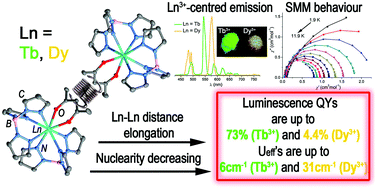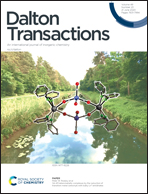Combination of single-molecule magnet behaviour and luminescence properties in a new series of lanthanide complexes with tris(pyrazolyl)borate and oligo(β-diketonate) ligands†
Abstract
A series of tris(pyrazolyl)borate mono-, di- and trinuclear complexes, [Tp2Ln]nX (Ln = Eu, Tb, Gd, Dy, Xn− = various mono-, bis- and tris(β-diketonates) has been prepared. The Tb3+ and Dy3+ complexes are luminescent single molecular magnets (SMM) and exhibit luminescence quantum efficiencies up to 73% for the Tb3+ and 4.4% for the Dy3+ compounds. Similar Eu3+ complexes display bright emission only at lower temperatures. The Dy3+ and Tb3+ complexes possess SMM behavior in a non-zero dc field at low temperatures, while the polynuclear Dy3+ complexes also show slow magnetic relaxation even in zero dc field up to 8 K. Ueff-values determined from dynamic magnetic measurements were up to 31 and 6 cm−1 for the Dy3+ and Tb3+ complexes, respectively. It was found that within a series of Dy3+ and Tb3+ compounds, Ueff and luminescence quantum yields decreased with increasing nuclearity of the compounds and a shortening of the intramolecular Ln–Ln distance. ΔOrbach-values estimated from low-temperature luminescence spectra were significantly higher than those obtained from ac magnetic data, which may be due to involvement of additional processes in the relaxation mechanism (quantum tunneling, Raman, direct) reducing the energy barrier. Some of the Tb3+-compounds also display metal-centred electroluminescence, giving them potential as emitting layers in LEDs.



 Please wait while we load your content...
Please wait while we load your content...